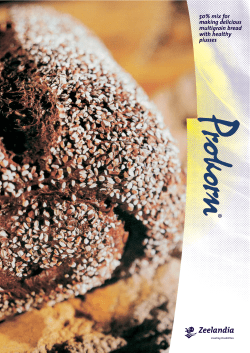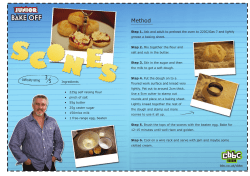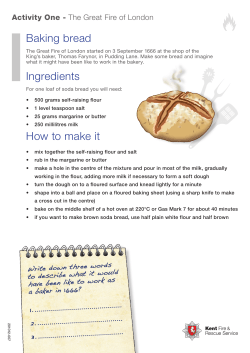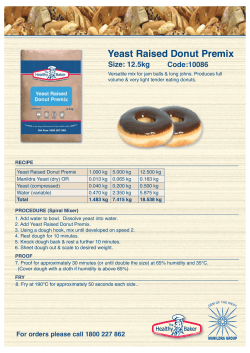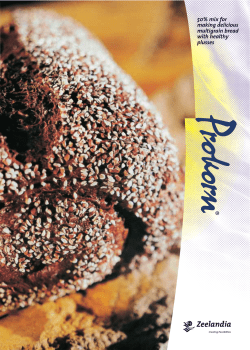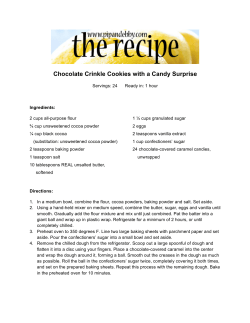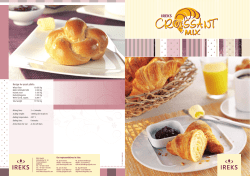
Chapter 7 Yeast Breads
Chapter 7 Yeast Breads Yeast • A living organism, one-celled fungus, with various strains present virtually everywhere. • It feeds on carbohydrates present in starches and sugars in bread dough, converting them to carbon dioxide and ethanol during fermentation: – Yeast + carbohydrates = alcohol + carbon dioxide On Baking: A Textbook of Baking and Pastry Fundamentals, Second Edition Labensky, Martel, Van Damme Copyright ©2009 by Pearson Education, Inc. Upper Saddle River, New Jersey 07458 • All rights reserved. Yeast Basics • Carbon dioxide is trapped in the dough made with yeast, leavening the bread while the alcohol evaporates. • Yeast is very sensitive to temperature and moisture. • Salt inhibits the growth of yeast and controls the dough’s rise. On Baking: A Textbook of Baking and Pastry Fundamentals, Second Edition Labensky, Martel, Van Damme Copyright ©2009 by Pearson Education, Inc. Upper Saddle River, New Jersey 07458 • All rights reserved. Types of Yeast • Bakers yeast is available in three forms: – Compressed, a mixture of yeast and starch with approximately 70% moisture content; it must be kept refrigerated. – Active dry, with virtually no moisture, is dormant and can be stored without refrigeration for months. – Instant dry can be added directly to dry ingredients in a bread formula without rehydrating. On Baking: A Textbook of Baking and Pastry Fundamentals, Second Edition Labensky, Martel, Van Damme Copyright ©2009 by Pearson Education, Inc. Upper Saddle River, New Jersey 07458 • All rights reserved. Natural Yeast Leaveners • Natural yeast starters used prior to the development of commercial yeast • Made by capturing wild yeast caught in a liquid dough mixture • Sourdough is a type of natural yeast starter with a characteristic tangy taste although all starter is not sour. On Baking: A Textbook of Baking and Pastry Fundamentals, Second Edition Labensky, Martel, Van Damme Copyright ©2009 by Pearson Education, Inc. Upper Saddle River, New Jersey 07458 • All rights reserved. Temperature for Yeast • Temperature affects yeast activity. On Baking: A Textbook of Baking and Pastry Fundamentals, Second Edition Labensky, Martel, Van Damme Copyright ©2009 by Pearson Education, Inc. Upper Saddle River, New Jersey 07458 • All rights reserved. Production Stages for Yeast Breads • Production is divided into 10 stages: – – – – – – – – – – Scaling the ingredients Mixing and kneading the dough Fermenting the dough Punching down the dough Portioning the dough Rounding the portions Make-up: Shaping the portions Proofing the products Baking the products Cooling and storing the finished products On Baking: A Textbook of Baking and Pastry Fundamentals, Second Edition Labensky, Martel, Van Damme Copyright ©2009 by Pearson Education, Inc. Upper Saddle River, New Jersey 07458 • All rights reserved. Obtaining Proper Dough Temperature • Yeast activity most beneficial when dough reached 75°F to 80°F ( 24°C to 27°C( after mixing. • Baker’s use formula for adjusting temperature of the water used to make bread dough. – The formula takes into consideration: the friction factor, how much machine mixing warms dough; ingredient temperature; and room temperature On Baking: A Textbook of Baking and Pastry Fundamentals, Second Edition Labensky, Martel, Van Damme Copyright ©2009 by Pearson Education, Inc. Upper Saddle River, New Jersey 07458 • All rights reserved. Mixing (Kneading) the Dough • Yeast breads are mixed by: – The straight-dough (direct) method or – A pre-fermentation, where dough is mixed in several stages: • Sponge • Old dough • Sourdough starter method • Kneading moistens ingredients and develops wheat gluten On Baking: A Textbook of Baking and Pastry Fundamentals, Second Edition Labensky, Martel, Van Damme Copyright ©2009 by Pearson Education, Inc. Upper Saddle River, New Jersey 07458 • All rights reserved. Fermentation • Fermentation enhances the taste and texture of the finished bread • Fermentation is divided into two stages: – Bulk, where the entire mass rises before shaping – Proofing, the rise given to shaped yeast just prior to baking • Fermentation time is controlled by three factors: – Ingredients – Dough temperature – Room temperature On Baking: A Textbook of Baking and Pastry Fundamentals, Second Edition Labensky, Martel, Van Damme Copyright ©2009 by Pearson Education, Inc. Upper Saddle River, New Jersey 07458 • All rights reserved. Baking Yeast Bread • Chemical changes take place during baking that add to yeast bread’s appeal – Washes applied before baking effect bread’s appearance – Scoring (slashing) or docking dough before baking improves bread’s appearance • Steam in the oven improves bread crust • Learning how to recognize when bread is fully baked essential On Baking: A Textbook of Baking and Pastry Fundamentals, Second Edition Labensky, Martel, Van Damme Copyright ©2009 by Pearson Education, Inc. Upper Saddle River, New Jersey 07458 • All rights reserved. Qualities of Bread • Bread is judged by: – – – – External and internal appearance Flavor Aroma Keeping properties On Baking: A Textbook of Baking and Pastry Fundamentals, Second Edition Labensky, Martel, Van Damme Copyright ©2009 by Pearson Education, Inc. Upper Saddle River, New Jersey 07458 • All rights reserved. Convenience Products • Bread bases are dry blends of specialty ingredients that must be added to a scratch formula or a mix. • Powdered sourdough starters give bread a tangy flavor. • Frozen dough enables restaurant operators to offer freshly baked bread. • Parbaked bread is solidified, unbrowned flashfrozen bread dough. On Baking: A Textbook of Baking and Pastry Fundamentals, Second Edition Labensky, Martel, Van Damme Copyright ©2009 by Pearson Education, Inc. Upper Saddle River, New Jersey 07458 • All rights reserved.
© Copyright 2025
